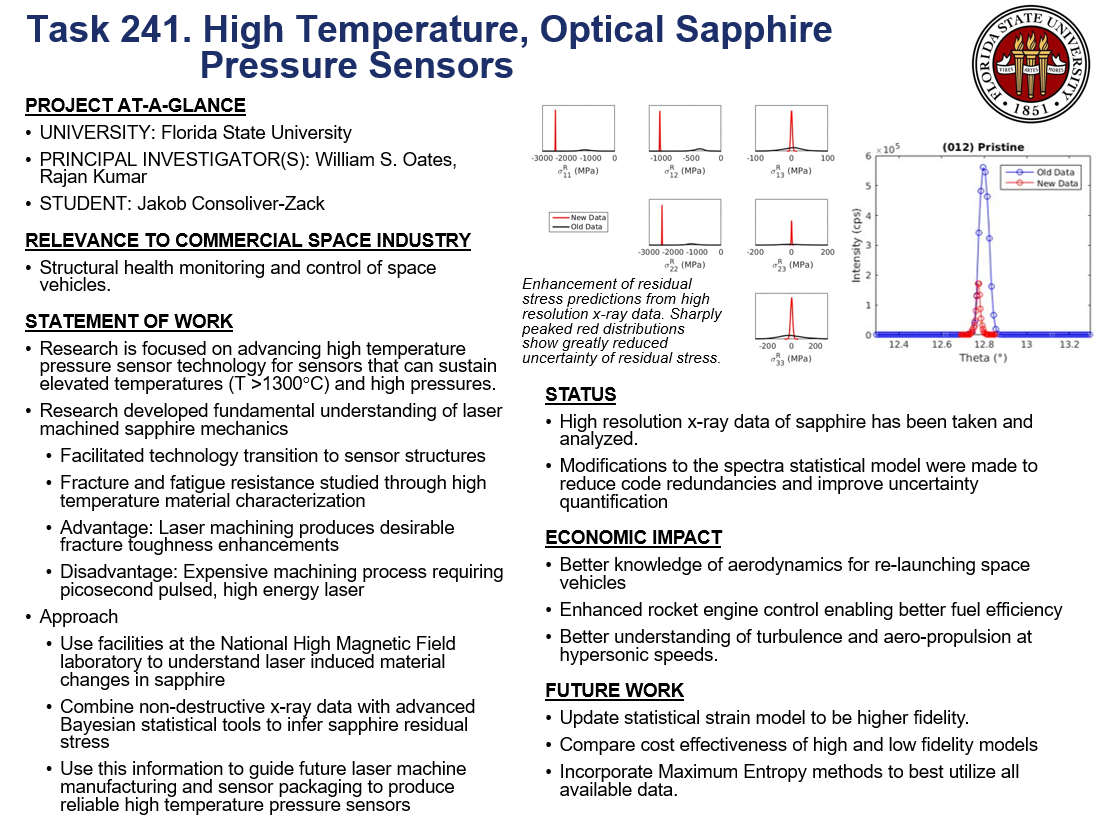241-FSU. High Temperature, Optical Sapphire Pressure Sensors for Hypersonic Vehicles
Team
| Name | Role | Primary |
| William Oates | Principal Investigator | ● |
| Nick Demidovich | Tech Monitor | ● |
| Yolanda Lopez | Fiscal Admin | ● |
Project Description
The study of hypersonic boundary layers is critical to the efficient design of hypersonic vehicles for rapid global and space access. The harsh environment makes conventional instrumentation unsuitable for time accurate, continuous, direct measurements. The development of a high temperature sensor for direct measurement of pressure is vital to the understanding of shock-wave/boundary layer interactions which directly influence critical vehicle characteristics such as lift, drag, and propulsion efficiency.
Project Outcomes
- Component testing of the sapphire pressure transducer will be conducted in the characterization facility at FSU. This will focus on analysis of the diaphragm and thermocompression bonding interface assembly. First, a mechanical load will be cycled quasi-statically on the diaphragm to determine its mechanical stiffness and linearity using aMTS load frame. Second, the sensor components will be exposed to high temperature in Oates’ furnace at temperatures that can reach 1600°C. The furnace will be modified to allow for in situ mechanical loading of the sapphire diaphragm at elevated temperatures. A series of test will be conducted under different mechanical cyclic loads (quasi-static) and temperatures to quantify any changes in diaphragm stiffness and hysteresis.
- The benchmark diaphragm test will be compared to a fully functional sapphire pressure sensor in the hot jet facility. The sensor will be compared to commercial high temperature Kulite pressure transducers. These comparisons will first be conducted at room temperature. We will also use either an IR camera or thermocouples to monitor the temperature in the vicinity of the pressure transducers. Through these measurements we will obtain performance characteristics that describe the achievable pressure range and bandwidth as a function of temperature.
- Measurements will be carried out on a typical reentry capsule module both in the normal impingement and glancing flow.
Summary of Output
Design a fiber optic lever pressure sensor with a remote photo-diode optical readout. The microphone is composed of a compliant, platinum coated, sapphire diaphragm bonded over a cavity containing a single optical fiber. The diaphragm deflection is detected via intensity modulation due to the motion of the reflective platinum coated sapphire diaphragm. The optical signal is routed via the high temperature sapphire fiber to a remote photo-diode allowing for insulation of the electronics from the harsh environment.
Quad Chart
